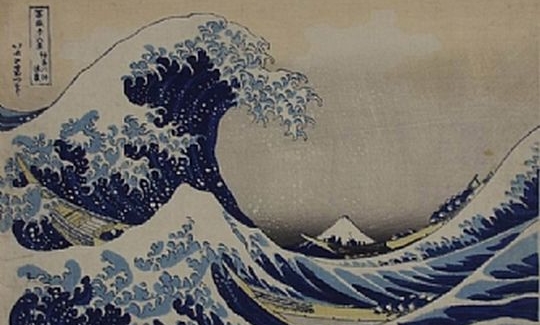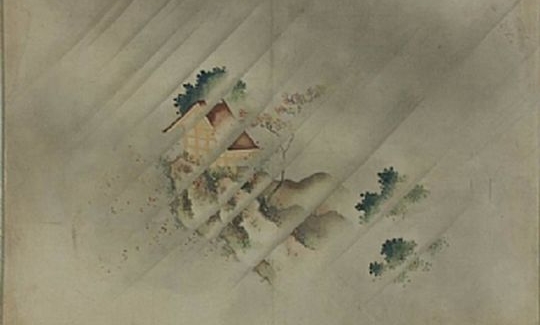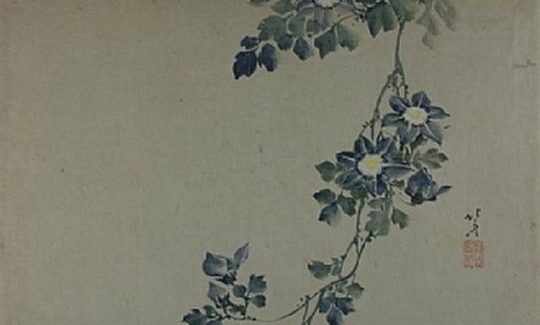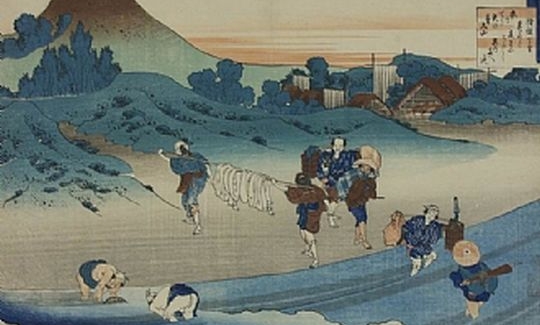Hokusai (1760-1849) is recognized as one of the greatest artists in the world. Throughout his long life he created more than 35,000 illustrations and sketches for some 500 books. He was born in Edo (today Tokyo) and his original name was Tokitaro. At about the age of three he was adopted into the family of the renowned craftsman Nakajima Ise, a maker of polished bronze mirrors for the rulers of Japan. By the age of five, Tokitaro was already revealing a talent for painting, and when he was nine his name was changed to Tetsuzo.
At around the age of thirteen he was working as an apprentice in a workshop where blocks were carved for printing. Two years later he himself was preparing wooden blocks for a short, humorous literary work. At fourteen he worked in a bookshop, and employed his skills in illustration and decoration. At eighteen years he was a pupil in the studio of the artist Katsukawa Shunsho (1726-1792) known primarily for his woodblock prints of actors of the Kabuki Theatre. In the summer of 1779 Hokusai also published a series of portraits of Kabuki actors, which he signed with the name Katsukawa Shunro. "Shunro" is one of the thirty names adopted by Hokusai in his lifetime. Others included Sori, Tamekazu, Manji, and Shinsai. However, he discarded most of these epithets after a short while, according to the changes in his artistic style. Little is known of Hokusai's life in the decade that followed. He earned his living mainly as an illustrator of books, and sometimes designed commercial prints.
The death of his teacher Shunsho in 1792 had a great effect, both on the Katsukawa School and on Hokusai's life. One of the pupils, Shunei, became head of the studio, an honour which Hokusai had hoped would come to himself. He severed all ties with the school and adopted the name Kusamura. The years 1793 and 1794 were critical for Hokusai's career because they signalled the end of his attempts to adapt himself to the traditional artistic style (the ukiyo-e) that was accepted at that time, and the beginning of creating his own personal style. For a short while he studied with the academic artist Kano Yusen, as well, apparently, as with Tsutsumi Torin, collaborating with the latter some years later in illustrating an album of poetry.
In 1795 Hokusai created illustrations for a collection of poems, the "Kyoka Edo Murasaki", which he again signed with a different name - Sori. From 1796 until 1799 he used this signature for many individual woodblock prints (ichimai-e) and illustrations for albums, all printed privately. His surimono prints for greeting cards and invitations received immediate acclaim.
Hokusai was a devout follower of the Nichiren Buddhist sect, relating in particular to the Bodhisattva Myoken as the embodiment of the North Star, and in 1776 he took the additional name Hokusai, by which he is known today. It means ‘the northern studio', and is one of the many names, among them Tatsumasa, Taito, and Raishin, deriving from the seven Pole Stars.
In the winter of 1798, the artist bestowed the name "Sori" on one of his pupils, and began using "Hokusai" as his own signature on paintings and prints. He signed "Satsumasa" on illustrations that were published privately, "Tokitaru" for commercial books, and "Kako" or "Sorobeku" for other prints and commercial works. In 1799, for a short while, he used "Fusenkyo", and in 1800, aged 41, he began to call himself "Gakyojin Hokusai" - "Hokusai, the man mad about painting". At an age when many of the artists who were his contemporaries thought of retiring, his career began to flourish. At the beginning of the 19th century, Hokusai was the most famous public figure in the Japanese art world. Even though he usually lived in seclusion, he greatly enjoyed the publicity, and occasionally even demonstrated his artistic prowess to an audience.
On his way to Kyoto in 1811, he stopped at the city of Nagoya, where he met the artist Bokusen (1775-1824). The outcome of the contact they maintained was the publication of the "Hokusai manga" - the sketches of Hokusai, a series of illustrated volumes published in Nagoya in the years 1814-1834. It was not the artist's original intention to create a series of humorous works, but they certainly depict the comic elements in scenes of everyday life. Hokusai's manga are quick, free, confident sketches, on the back of which he signed himself - "painted by a madman (Gakyojin)" or "Crazy paintings by an old man (Gakyo Rojin)".
The Japanese calendar divides time into periods of 60 years. In 1820, Hokusai marked the beginning of his second period by adopting the name "Iitsu" ("One year old again"). In that decade he created his last series of surimono, but he continued to illustrate books on various subjects. In 1827 he suffered a stroke, but recovered with the help of medical treatment.
In 1831 Hokusai began to produce series of woodblock prints of views of Japan, the most famous of which is "Thirty-six views of Mount Fuji" (Fugaku Sanjurokkei). The influence of western art, deriving from engravings brought to Japan from Holland, is very evident in these prints. Hokusai learned the principles of western perspective and the realism characteristic of European art of that period.
In the early 1830s, in his eighth decade, Hokusai continued to work without slackening. He completed the series of views of Mount Fuji, and created prints of waterfalls, bridges, birds, and demons. He left Edo, and lived for more than a year in the countryside near Uruga on the Miura Peninsula, south of Edo. Here he continued to work, and sent his publishers illustrations for books accompanied by long letters with instructions as to how to carve the wooden blocks and print them.
It was during this period that the last great series of prints began to appear, for an anthology of classic Japanese poetry - "Illustrations for the Poems of One Hundred Poets as explained by Minkat" (Hyakunin isshu uba ga etoki). In the summer of 1836, Hokusai returned to Edo, where a famine was raging. He managed to survive by selling prints and drawings, or exchanging them for rice. The poetry series was discontinued after only 27 works, and was never completed, even though Hokusai continued to add to it in the summer of 1839. In the same year, the building in which his works were stored caught fire, and all his studies and equipment went up in flames. In the last decade of his life, Hokusai continued to paint, but he made no more prints, illustrated no more books.
At the age of 82 he drew, every morning, a lion-dog (shishi) to charm away evil spirits, and he continued the practice for two years. In 1845, during a visit to a friend in Shinano Province (today Nagano) he made several paintings for the local temple.
Hokusai died in 1849, and is buried in the Seikyoji Temple in the Asakusa Quarter of Edo. Many of his students adopted names that began with the syllables "Hoku". The most renowned of these was the surimono artist Totoya Hokkei (1780-1850). Another student, Katsushika Taito II, who worked from the 1820s to the beginning of the 1850s, created many prints, of which several have been erroneously attributed to Hokusai himself.
Hokusai's long life was full of changes, a constant search for means of expression and new styles. This is very evident in his lively, restless lines. He frequently changed his place of residence - 93 times in all, and, in one instance, even twice on the same day...




